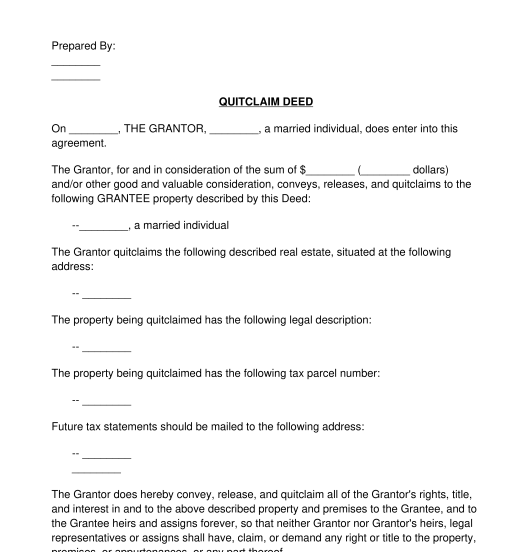 09/04/2025
09/04/2025

Answer a few questions and your document is created automatically.

Your document is ready! You will receive it in Word and PDF formats. You will be able to modify it.




Rating: 4.8 - 350 votes
Download a basic template (FREE) Create a customized documentA quitclaim deed is a legal document used to transfer real property from one person, known as the grantor, to another person, known as the grantee. It is often used to transfer property between family members or other parties who know each other. A Quitclaim Deed can also be used to relinquish co-owned property in situations such as divorce. Other common uses of Quitclaim Deeds include the following:
The property being transferred using a quitclaim deed is known as real property, or real estate. It includes things such as houses, commercial buildings, or empty plots of land. The transfer can happen in exchange for some kind of payment from the recipient. However, in many situations, the transfer does not involve money.
Though both of these documents are used to transfer property from one party to another, they are very different in the protections they provide to the party receiving the property.
A quitclaim deed transfers any interest the grantor has in the property to the grantee without making any promises about how much interest they have. There may be liens, mortgages, or other encumbrances on the property. The grantee receives only the interest that the grantor has, which could be none depending on the situation.
A warranty deed transfers property from the grantor to the grantee with the promise that they hold clear title and there are no liens or other encumbrances on the property. A warranty deed is much lower risk for the grantee than a quitclaim deed.
No, a quitclaim deed is not mandatory. Depending on the situation, a warranty deed may also be used. However, a quitclaim deed is useful in situations where property interests need to be transferred without a warranty. It is most suitable for transferring property between family, divorce settlements, or adding/removing names on a property title.
In the context of a quitclaim deed, an encumbrance is any claim, lien, or mortgage associated with the property. This could be mortgages, easements, or unpaid property taxes. A quitclaim deed means that the property may have encumbrances that the grantee will have to deal with once the property is transferred.
Before creating a quitclaim deed, the parties should conduct a title search to be sure that the grantor has the legal right to transfer the property. This would also reveal any existing liens or encumbrances on the property. A title search is done using a title company.
A quitclaim deed is used by someone who has interest in a property, known as the grantor, who then transfers their interest to another party, known as the grantee. Generally, the parties, if they are individual people, must 18 years of age or older. In situations involving a minor, a parent or legal guardian may sign on their behalf.
When the quitclaim deed is written and all the relevant information has been included, the document should be printed out and signed by both the grantor and grantee in front of a notary. The notarized document should then be filed in the local county clerk or registry office. The finalized document can be sent to the grantee after it has been recorded with the county.
Yes, a quitclaim deed should be signed in front of a notary public, who then completes the notary page. Notary publics are individuals authorized by the state to perform notarization. Notaries can be found at various locations, including banks or credit unions, law offices, mail and shipping stores, government offices, libraries, and online notary services. Some notaries work by appointment, while others accept walk-ins.
The notary the parties use does not need to be in any particular state or location, as long as they are a registered notary in the state where they are providing their notarization services.
The quitclaim deed should be registered with the county clerk or registry office, depending on the jurisdiction in which the property is located.
A quitclaim deed must include at least the following mandatory clauses:
Quitclaim deeds are governed by state law. Different states have different requirements for when and how the deed should be filed. Contact the local county Register of Deeds to get information about which governmental agency should be given the deed to file and record before being returned to the grantee.
You fill out a form. The document is created before your eyes as you respond to the questions.
At the end, you receive it in Word and PDF formats. You can modify it and reuse it.
A guide to help you: How to Notarize a Document
Quitclaim Deed - FREE - Sample, template - Word and PDF
Country: United States